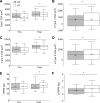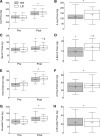Neither load nor systemic hormones determine resistance training-mediated hypertrophy or strength gains in resistance-trained young men
- PMID: 27174923
- PMCID: PMC4967245
- DOI: 10.1152/japplphysiol.00154.2016
Neither load nor systemic hormones determine resistance training-mediated hypertrophy or strength gains in resistance-trained young men
Abstract
We reported, using a unilateral resistance training (RT) model, that training with high or low loads (mass per repetition) resulted in similar muscle hypertrophy and strength improvements in RT-naïve subjects. Here we aimed to determine whether the same was true in men with previous RT experience using a whole-body RT program and whether postexercise systemic hormone concentrations were related to changes in hypertrophy and strength. Forty-nine resistance-trained men (23 ± 1 yr, mean ± SE) performed 12 wk of whole-body RT. Subjects were randomly allocated into a higher-repetition (HR) group who lifted loads of ∼30-50% of their maximal strength (1RM) for 20-25 repetitions/set (n = 24) or a lower-repetition (LR) group (∼75-90% 1RM, 8-12 repetitions/set, n = 25), with all sets being performed to volitional failure. Skeletal muscle biopsies, strength testing, dual-energy X-ray absorptiometry scans, and acute changes in systemic hormone concentrations were examined pretraining and posttraining. In response to RT, 1RM strength increased for all exercises in both groups (P < 0.01), with only the change in bench press being significantly different between groups (HR, 9 ± 1, vs. LR, 14 ± 1 kg, P = 0.012). Fat- and bone-free (lean) body mass and type I and type II muscle fiber cross-sectional area increased following training (P < 0.01) with no significant differences between groups. No significant correlations between the acute postexercise rise in any purported anabolic hormone and the change in strength or hypertrophy were found. In congruence with our previous work, acute postexercise systemic hormonal rises are not related to or in any way indicative of RT-mediated gains in muscle mass or strength. Our data show that in resistance-trained individuals, load, when exercises are performed to volitional failure, does not dictate hypertrophy or, for the most part, strength gains.
Keywords: anabolism; growth hormone; load; strength training; testosterone.
Copyright © 2016 the American Physiological Society.
Figures





References
-
- Alegre LM, Aguado X, Rojas-Martin D, Martin-Garcia M, Ara I, Csapo R. Load-controlled moderate and high-intensity resistance training programs provoke similar strength gains in young women. Muscle Nerve 51: 92–101, 2015. - PubMed
-
- Burd NA, Moore DR, Mitchell CJ, Phillips SM. Big claims for big weights but with little evidence. Eur J Appl Physiol 113: 267–268, 2013. - PubMed
-
- Burd NA, West DW, Staples AW, Atherton PJ, Baker JM, Moore DR, Holwerda AM, Parise G, Rennie MJ, Baker SK, Phillips SM. Low-load high volume resistance exercise stimulates muscle protein synthesis more than high-load low volume resistance exercise in young men. PLoS One 5: e12033, 2010. - PMC - PubMed
-
- Campos GE, Luecke TJ, Wendeln HK, Toma K, Hagerman FC, Murray TF, Ragg KE, Ratamess NA, Kraemer WJ, Staron RS. Muscular adaptations in response to three different resistance-training regimens: specificity of repetition maximum training zones. Eur J Appl Physiol 88: 50–60, 2002. - PubMed
Publication types
MeSH terms
Substances
LinkOut - more resources
Full Text Sources
Other Literature Sources
Medical

